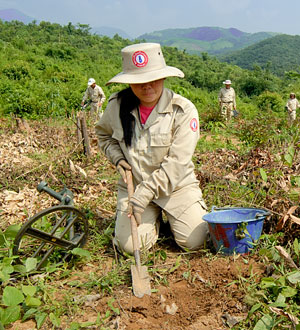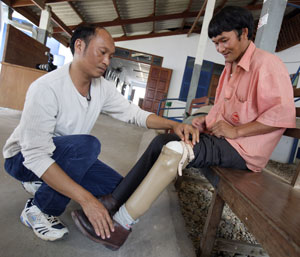Xayphone Seankhambou carefully digs for unexploded ordnance (UXO) in remote Sekong Province in Southern Laos.
She searches for bombs dropped more than 40 years ago that are a risk to lives and limit the community's use of the land.
'I believe my work is very important as it helps the Lao people,' the clearance worker says. 'It also helps the country have more land safe from UXO for farming and other development activities.'
Australia is a longstanding supporter of UXO clearance in Laos, as part of comprehensive action that includes risk awareness, victim assistance and better planning of activities.
More than 580,000 bombing missions were carried out over Laos between 1964 and 1973. Over two million tons of bombs were dropped, making it the most heavily bombed country in the world. It is estimated that up to a third of the country – about 87,000 square kilometres – is contaminated by UXO. Around 270 square kilometres or 0.3 per cent has been cleared to date. Given the enormity of the clearance challenge facing the country, the Government of Laos has identified 2,000 square kilometres or 200,000 hectares to be cleared as a priority by 2016 and Australian support is helping clearance efforts.
The widespread contamination of agricultural land makes UXO a central cause of poverty in rural Laos. Most villagers depend on agriculture for incomes and they also collect food from the land. Contamination reduces their ability to use or get the most out of the production potential of their land.
While they're reluctant to use contaminated land, villagers often have to risk walking in uncleared areas or working in dangerous fields if they are to sustain themselves and their families. As a result, dozens of people are killed or injured by UXO each year. While casualties are falling – from 302 in 2008 to 92 in 2011 – children make up a rising proportion of casualties. Hospitals and clinics struggle to help victims' rehabilitation, increasing the emotional, social and financial burden on poor families.
Australia is providing $6.2 million for a comprehensive program of UXO activities from 2009 to 2013 support that is aligned with Government of Lao priorities.
In 2011 Australia's support helped the UXO Lao, the national clearance agency, to clear 2,938 hectares of contaminated land, benefiting around 460,000 people who could safely use land for crops and businesses. This program also provided 587 UXO risk awareness raising activities that reached 143,000 people, including 77,000 children. In 2011 Australia also supported non-government organisations to clear 239 hectares of land to benefit more than 17,000 people who can now safely plant food crops.
In 2011, Australia helped the Cooperative Orthotic and Prosthetic Enterprise (COPE) Centre provide prosthetics and orthotics to more than 250 survivors of unexploded ordnance in 2011.
Since 1996, Australia has helped Laos to strengthen its capacity to plan, coordinate and manage UXO activities by supporting the National Regulatory Authority that oversees and regulates the UXO sector. Australian aid is helping the Government of Laos to meet its obligations under the Convention on Cluster Munitions and other international disarmament treaties.
Australian support has also improved data collection and tracking of casualties, to better target support for survivors, and trialled better district-level coordination of UXO activities in some of the poorest and most contaminated areas of the country.
Naovanglee Norvaly is wearing shoes for the first time in almost 20 years, thanks to a professionally-made prosthetic leg provided through Australian support for action on unexploded ordnance in Laos.
Naovanglee lost his leg below the knee after stepping on a cluster bomb, known as a bombie, while scouting for areas to plant a rice crop. For almost two decades he hobbled around on a wooden leg hand made by craftsmen in his remote village. 'They would last only six months to two years, depending on the quality of the wood,' he said.
Naovanglee had given up wearing shoes. 'It would have been wasteful to buy two and only wear one.' He was fitted with a prosthetic leg provided by the Cooperative Orthotic and Prosthetic Enterprise (COPE) Centre, the only provider of prosthetic and orthotic services in Laos, which works in partnership with the Lao Government's National Rehabilitation Centre. Australia is providing $600,000 to the centre from 2011 to 2014, as part of a comprehensive program of support for unexploded ordnance (UXO) action in Laos.
More information
Making a difference: Australia's support for the UXO sector in Laos
Mine Action Strategy for the Australian aid program 2010-14


